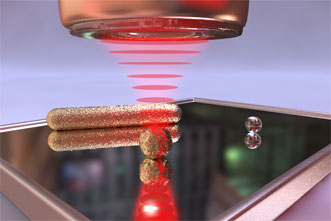A new type of microscope uses an optical cavity to enhance image signals dramatically and enable detailed measurements of the structure and movements of individual nanoparticles.
The technique has potential applications in biology, chemistry, and nanoscience, according to researchers at Ludwig Maximilian University and the Max Planck Institute for Quantum Optics. For example, it could be used to study temporal dynamics of macromolecules, such as the folding of proteins, as well as to characterize nanomaterials and take spectroscopic measurements of quantum emitters.

An illustration of a new scanning cavity microscope for imaging nanoparticles. Courtesy of Christoph Hohmann/Nanosystems Initiative Munich.
"Our approach is to trap the probe light used for imaging inside of an optical resonator, where it circulates tens of thousands of times," said David Hunger, who led the team that built the microscope. "This enhances the interaction between the light and the sample, and the signal becomes easily measurable. For an ordinary microscope, the signal would be only a millionth of the input power, which is hardly measurable. Because of the resonator, the signal gets enhanced by a factor of 50,000."
One side of the resonator is made of a plane mirror that also serves as a carrier for the nanoparticles under investigation. The counterpart is a strongly curved mirror on the end facet of an optical fiber.
Laser light is coupled into the resonator through the fiber. The plane mirror is moved with respect to the fiber in order to bring the particle into focus. At the same time, the distance between both mirrors is adjusted in order to fulfill the condition for the appearance of resonance modes. This requires an accuracy in the range of picometers.

For their first measurements, the scientists used gold spheres with a diameter of 40 nm.
"The gold particles serve as our reference system, as we can calculate their properties precisely and therefore check the validity of our measurements," Hunger said. "Since we know the optical properties of our measurement apparatus very accurately, we can determine the optical properties of the particles from the transmission signal quantitatively and compare it to the calculation."
In contrast to other methods relying on direct signal enhancement, the light field is limited to a very small area, such that by using only the fundamental mode, a spatial resolution of 2 μm is achieved. By combining higher-order modes, the scientists could even increase the resolution to around 800 nm.
The method becomes even more powerful when both absorptive and dispersive properties of a single particle are determined at the same time. The corresponding quantities depend on the orientation of the polarization of light with respect to the symmetry axes of the particle. In this case, the team used gold nanorods that measured 34 × 25 × 25 nm.
"If the polarization is oriented parallel to the axes of the rod, the shift of the resonance is larger than if the polarization is oriented orthogonally, resulting in two different resonance frequencies for both orthogonal polarizations," said doctoral student Matthias Mader. "This birefringence can be measured very precisely and is a very sensitive indicator for the shape and orientation of the particle."
The research was published in Nature Communications (doi: 10.1038/ncomms8249 [open access]).
For more information, visit www.mpq.mpg.de.